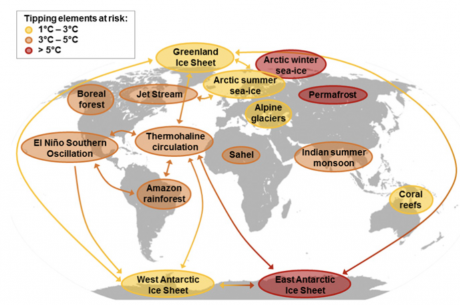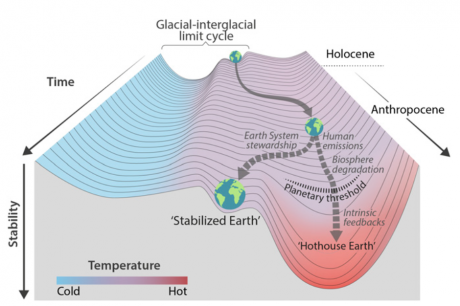Tipping Points
This is a map of potential tipping points on the Earth systems or domino effects that we will get with a rising temperature(Fig. 1)(Steffen et al., 2018) which, in the worst case, could lead to a so-called Hothouse Earth scenario (Fig. 2), (Steffen et al., 2018). The Paris Agreement’s goal is to keep global average temperature “well below 2°C” and aiming for 1.5°C above pre- industrial levels, to reach this goal we need to half the emissions by 2030 (ca 7%/year and with 30% until 2025).
Will Steffen is a good name to remember, he is among other things known for advocating with Paul Crutzen the concept of the Anthropocene. Initiating with Johan Rockströmthe international debate on planetary boundaries.
Here is a good clip when he is explaining how everthing si conected;
https://www.youtube.com/watch?v=nUaw0-PF-Cg
Text for figures from PNAS article “Trajectories of the Earth System in the Anthropocene”
https://doi.org/10.1073/pnas.1810141115
Fig. 1 Global map of potential tipping cascades. The individual tipping elements are color- coded according to estimated thresholds in global average surface temperature (tipping points) (12, 34). Arrows show the potential interactions among the tipping elements based on expert elicitation that could generate cascades. Note that, although the risk for tipping (loss of) the East Antarctic Ice Sheet is proposed at >5 °C, some marine-based sectors in East Antarctica may be vulnerable at lower temperatures
Fig. 2 Stability landscape showing the pathway of the Earth System out of the Holocene and thus, out of the glacial–interglacial limit cycle to its present position in the hotter Anthropocene. The fork in the road in Fig. 1 is shown here as the two divergent pathways of the Earth System in the future (broken arrows). Currently, the Earth System is on a Hothouse Earth pathway driven by human emissions of greenhouse gases and biosphere degradation toward a planetary threshold at ∼2 °C (horizontal broken line at 2 °C in Fig. 1), beyond which the system follows an essentially irreversible pathway driven by intrinsic biogeophysical feedbacks. The other pathway leads to Stabilized Earth, a pathway of Earth System stewardship guided by human-created feedbacks to a quasistable, human-maintained basin of attraction. “Stability” (vertical axis) is defined here as the inverse of the potential energy of the system. Systems in a highly stable state (deep valley) have low potential energy, and considerable energy is required to move them out of this stable state. Systems in an unstable state (top of a hill) have high potential energy, and they require only a little additional energy to push them off the hill and down toward a valley of lower potential energy.




